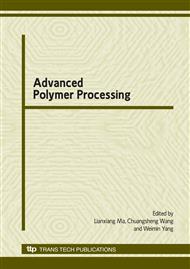p.74
p.80
p.86
p.92
p.98
p.104
p.110
p.116
p.119
Carbon Nanofibers from Pyrolysis Flame and Research on the Affecting Factors
Abstract:
Synthesis of carbon nanofibers from the V-type pyrolysis flame is a new method and it has wide application prospects. It needs simple laboratory equipments and normal atmosphere pressure. The V-type pyrolysis flame experimental system is introduced, involving V-type pyrolysis flame burner, mass flux controllers, sampling substrate etc. The carbon nanofibers were characterized by scanning electron microscope and transmission electron microscope. Carbon nanofibers with less impurities and high quality can be captured when the temperature was from 800 to 880°C, austenitic stainless steel type304 was served as sampling substrate, nickel nitrate was served as catalyst precursor and sampling time was 5 minutes. The carbon nanofibers are from 100 to 200 nm in diameter and dozens microns in length. The average diameter of catalyst particles is approximately from 20 to 50 nm. The effects of temperature, sampling substrate materials, sampling time and catalyst were analyzed. The temperature determined the diameter and shape of carbon nanofibers. The austenitic stainless steel type304 substrate containing nickel is in favor of synthesis of carbon nanofibers. The number of carbon nanofibers got more and more while the diameter got thicker firstly and then had little change with the sampling time increased within 5 minutes. In addition, experimental results also indicated that carbon nanofibers had much impurity and worse morphology if the diameter of catalyst particles was above 50nm.
Info:
Periodical:
Pages:
98-103
Citation:
Online since:
December 2009
Authors:
Price:
Сopyright:
© 2010 Trans Tech Publications Ltd. All Rights Reserved
Share:
Citation:


